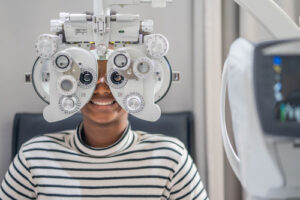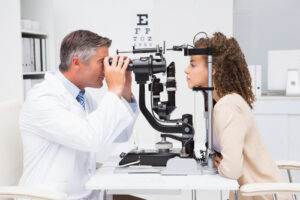Eyeglasses are an important part of everyday life for those with refractive errors. Whether you have nearsightedness, farsightedness, or astigmatism, it’s likely you rely on your prescription glasses for a variety of tasks, if not all.
Keep reading to find out how your eye doctor determines your glasses prescription!
What Are Refractive Errors?
Refractive errors are vision problems that can cause blurriness. They include nearsightedness, farsightedness, astigmatism, and presbyopia.

Refraction is how your eye bends light, and it plays a crucial role in clear vision. Having a refractive error means your eye struggles to bend light properly so that it reaches the back of your eye, known as the retina.
This occurs because your eye has an irregular shape. In a healthy eye without refractive errors, the shape allows light to focus accurately on the retina at the back of the eye.
However, when your eye has a different shape, it cannot bend the light correctly, resulting in blurry vision. For instance, your eyeball may be too long or too short, or the front part of your eye, called the cornea, may have an irregular shape.
How Does My Eye Doctor Know If I Need an Updated Glasses Prescription?
When you visit your eye doctor for an eye exam, they will check whether your prescription has changed. For some people, their prescription needs to be updated every one to three years.
For others, it’s more stable. Before your eye doctor performs any tests,
they will also ask if you’ve noticed any changes in your vision or if you’re having any difficulties related to your vision.

A conversation about any symptoms you may be experiencing is a vital part of your appointment. If you’ve noticed that your vision has worsened, that’s an indicator that you may need a new prescription.
The next step is for your eye doctor to evaluate your vision. To test your distance vision, they will ask you to read letters of varying sizes from a chart, covering one eye at a time.
This is called a visual acuity test. Your eye doctor will then have you look through a machine called a phoropter to perform a refraction test.
A refraction test will determine your glasses or contact lens prescription. This machine contains a range of lenses with different powers.
They will try different lenses and ask which is clearer to determine which power lens works best for you.
What Is An Auto-Refraction Test?
An auto-refraction test is a machine-based method used by eye doctors to determine your prescription. It measures how light moves as it passes through your eye.

This test helps establish an initial prescription baseline. During the auto-refraction test, you will be seated in front of the machine.
The machine will emit light into your eye, while you observe alternating images of clarity and blurriness. It evaluates how light is refracted off your retina and identifies when your eye achieves focus.
Unlike a phoropter test, you don’t need to inform the doctor when your vision is clear. The auto-refractor machine can automatically detect it.
This test only takes a few seconds to complete, providing your doctor with a reliable starting point for your prescription.
How Do Glasses Work?
Glasses work by correcting refractive errors in your vision. They help your eye properly refract light, allowing it to focus precisely on the retina, resulting in clear vision.
Without a refractive error, light is naturally focused directly onto the retina. However, if you are nearsighted, farsighted, or have astigmatism or presbyopia, this ideal focusing is disrupted.
Sometimes, the light is focused either too far in front or too far behind the retina. By using corrective lenses, the path of light is altered to ensure it lands directly on the retina.
The lens power alone is not the sole determinant of achieving clear vision. Lenses can also possess varying degrees of curvature and thickness to compensate for irregularities in the shape of your eyes.
Can My Glasses Prescription Change Over Time?
It is possible for your glasses prescription to change over time. Your eyesight can fluctuate for various reasons, such as age, changes in eye health, and lifestyle factors.

As you grow older, it’s common for your eyes to undergo natural changes. This can lead to a need for different prescription strengths.
Conditions like nearsightedness, farsightedness, or astigmatism can progress or stabilize over time, affecting your prescription. Other factors that can contribute to changes in your glasses prescription include eye injuries, certain medications, hormonal fluctuations, and even pregnancy.
Additionally, lifestyle changes, such as spending excessive time in front of screens or working in specific environments, can impact your vision and require adjustments to your prescription. To ensure clear and comfortable vision, it’s essential to have regular eye examinations.
Your eye doctor can assess any changes in your prescription and update it accordingly. Remember, keeping your prescription up to date is crucial for maintaining optimal vision and eye health.
Is it time you had your vision checked? Schedule an appointment at Cheema MD Eye Care in Kingston, NY, today!



